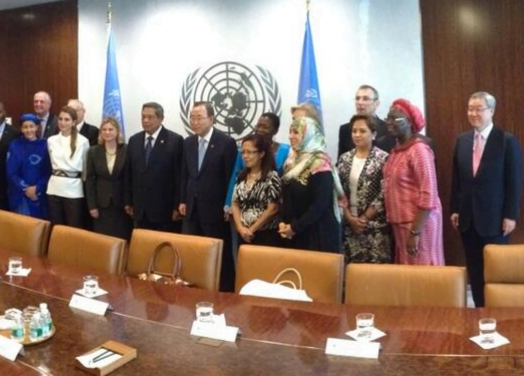This is a big moment for the international development community, donor nations, developing countries…and maybe even human beings as a species.
For nearly a year, a group of 27 top international figures — known around the UN as The High Level Panel of Eminent Persons on the Post 2015 Development Agenda — have been hashing out what kind of international development strategy should replace the Millennium Development Goals when they expire in 2015. The group is co-lead by UK Prime Minister David Cameron, Liberian President Ellen Johnson Sirleaf, and President Susilo Bambang Yudhoyono of Indonesia. They’ve been holding meetings, consultations, and panels around the world — including an unprecedented effort to solicit input from ordinary citizens — to shape their report. Today panel is officially presenting their 12 recommendations to Ban Ki Moon and the UN.
The top recommendation is a target to eradicate extreme poverty by 2030. That will probably grab most headlines, and rightfully so. The previous Millennium Development Goal sought to halve the number of people living on less than $1.25/day by 2015. That goal was achieved (thanks largely to economic growth in India and China) and now the High Level Panel has upped the ante. “We can be the first generation in human history to end hunger and ensure that every person achieves a basic standard of wellbeing,” says the report.
Like the new poverty eradication goal, many targets contained in this report simply build on the MDGs. That includes new targets for women’s health, maternal mortality, AIDS, TB and Malaria. But many of the recommendations are driven by climate and sustainability concerns, which were largely ignored by the MDGs. For example, the panel takes wholesale the Secretary General’s Sustainable Energy for All targets of universal access to modern energy services, doubling the share of renewables in the global energy mix, and doubling the global rate of energy efficiency. Ecological targets are included in the recommendations, which were also left out of the MDGs.
Perhaps the biggest difference of these new targets from the MDGs is that there is a human rights and good governance agenda embedded in them. Goals 10 and 11 cover things like reducing bribery; reducing violent deaths; proving universal access to legal documents like birth registrations; and ensuring accountability in the legal system. I would imagine that these will be difficult agendas to pursue as some governments may chafe at the idea of allowing this degree of openness, but it’s precisely the formation of these kinds of goals that provide the peer pressure that nudges governments become more transparent.
Aside from the specific targets contained in the report, the biggest departure of these recommendations from the MDGs is conceptual. The MDGs were very much about the various ways in which the developed world can help the developing world help itself. That was probably appropriate for the era, but today would be anachronistic. Rather, this report envisions a wide variety of stakeholders brought into the fold. “It’s a universal agenda which will require country plans, but with responsibilities to everyone in the global system,” says John Podesta who was the American member of the High Level Panel.
From the report:
A new partnership should be based on a common understanding of our shared humanity, underpinning mutual respect and mutual benefit in a shrinking world. This partnership should involve governments but also include others: people living in poverty, those with disabilities, women, civil society and indigenous and local communities, traditionally marginalised groups, multilateral institutions, local and national government, the business community, academia and private philanthropy. Each priority area identified in the post-2015 agenda should be supported by dynamic partnerships.
This is a relatively novel concept that will be central to the success of a new development agenda.
Another good nugget of this proposal–and something that wonks will love — is its emphasis on using good data. The panel proposes a new Global Partnership on Development Data that pulls in all the stakeholders mentioned above to make sure that the international community is using the same math, that the data are reliable, and is available to tall. Michael Elliot, president and CEO of the ONE Campaign is particularly pleased with the idea of a global body that will coordinate and crunch all the data. “The HLP’s call for a data revolution to strengthen accountability and transparency is hugely important,” he says.
Onto the 12 goals! Here they are:




It’s important to keep in mind that these are just recommendations, and not some final determination of what will replace the MDGs. “This report is the staring gun, not the finish line in the post-2015 agenda,” says Podesta.
In order for these recommendations to be codified in any meaningful way the General Assembly will have to formally get on board. The Secretary General is set to issue his own set of recommendations which will kick off a big debate during UN Summit Week in September and continue for the year. The High Level Panel report is such a big deal because these 12 recommendations — and the conceptual underpinnings from which they flow– will define the paramaters of the discussion.
The MDGs were a transformational political force over the last 13 years. The goals made sure that things like reducing child mortality and fighting AIDS on the international agenda even in those tough years after the September 11th attacks. The results have been impressive. If humanity can coalesce around these new targets, billions of lives will become dramatically improved in the next 15 years. That would be a turning point in the evolution of our species.
